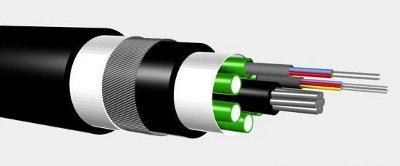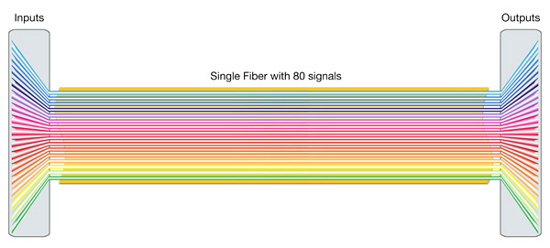London Colocation and Managed Private Circuits
Fri, 22 Mar 2013
networking
Connecting data centre and colocation based services in the London area with secure isolated layer 2 throughput can be done in various ways. Commonly, larger ISPs and the like, with large bandwidth requirements, will rent physical cables from infrastructure providers - see this earlier blog to learn more about underground fibre infrastructure.
Core cables are actually bunches of fibre optical tubes rented out individually or in bundles to network providers who will 'light' that cable with lasers to provide the layer 1 medium for data transfer (although some infrastructure providers do provide 'lighting' services as part of their product portfolio), click here for an introduction to the different networking layers.

A cross section of single-mode optical fibre cable
Laser lit fibre provides an excellent layer 1 platform for connecting data centres by being able to transport binary signals over vast distances unaffected by electrical or magnetic interference.
Two kinds of fibre connectivity exist, single mode and multi-mode, with single-mode providing this long distance connectivity. The difference between the two comes down to the design and quality of the fibre cable and the laser transceivers lighting it. Single-mode uses superior cables and lighting and can transport data over 50 miles without amplification or dispersion reduction techniques.
Multiplexing technology is known Wave Division Multiplexing (WDM) because, in addition to combining multiple data streams, multiple frequencies, or frequency 'waves', can also be created by using different colour lasers. By utilising the complete spectrum of laser colours, WDMs can multiply a single 1Gbps or 10Gbps connection by up to 16 times, creating a total throughput of up to 160Gbps over a single fibre.

These images represent the concept of DWDM transmission
Needless to say, using WDM technology is costly and requires expensive transmitting and receiving hardware, including high quality optical cable itself. For many network operators, the outlay required for WDM equipment, the direct renting of fibre cable and the massive gigabit throughput throughput, is either beyond their budgets or wholly unnecessary .
Alternatives do exist. Stepping back from WDM, many smaller network operators and colocation customers will simply rent a single wavelength on the WDM provisioned circuit. By renting out wavelengths, owners of WDM equipment are more able directly recoup their investment.
On the other hand, smaller network operators gain access to the single mode transmission circuit without the capex of purchase, installation and management that it entails. Smaller network operators are able to take large connections between their networking equipment with the peace of mind knowing that they are renting a secure layer 1 medium and have total freedom over their layer 2 service.
Though a large network operator may sell off a wavelength to a smaller network operator, that wavelength of 1 to 10Gbps, may still be overkill for a third network operator who only needs a few Mbps between sites to create a simple WAN, VLAN, MPLS or Point to Pont connection.
A wavelength of 1 to 10Gbps is overkill for a network operator who only needs a few Mbps between sites
To enable layer 2 connectivity at this scale, the wave length must again be resold but this time, the third network operator has no concern or even knowledge of the single-mode fibre optic technologies being used to deliver their service between sites. For this provider, a copper or multi-mode fibre port leading from his switch to his service provider's switch is all that is seen.
For the majority of clients looking for layer 2 interconnects around 10Mbps and 1Gbps space, the benefits of taking a this kind of managed layer 2 circuit well outweigh the benefits of more directly accessing inter-site connectivity via WDM systems or rented waves. Avoiding the associated cost outlays, set up fees and maintenance are an obvious major benefit, however, there also are others, listed here:
- Use copper CAT cables - the option of using a copper cables further decreases costs
- Short contracts – the ability to react to business changes on a month to month basis
- Protected circuits – users inherit a diverse path to and from destinations, providing layer 1 and 2 redundancy
- Protocol options - able to use any Ethernet based LAN or WAN, or other layer 2 signalling
Furthermore, should network operators use the services of ConnetU, they will able to interconnect between up to 14 data centres in the London area.
Come join us on: